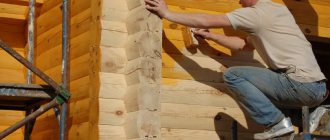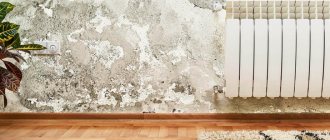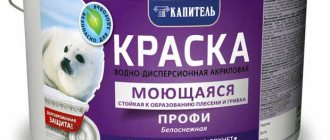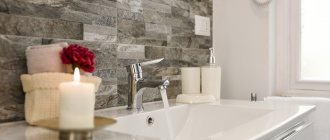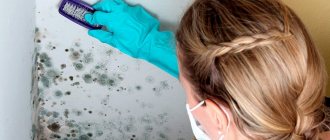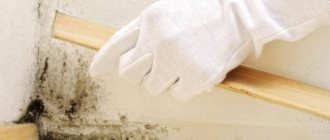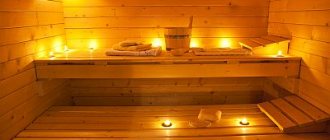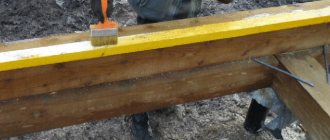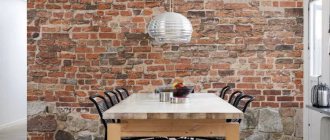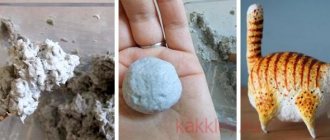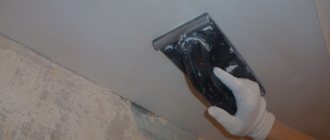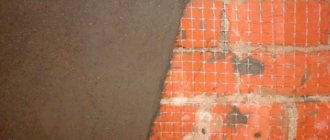It turns out that mold colonies can settle on concrete surfaces. This occurs in damp rooms, where a favorable climate is created for the growth of mold. Its harm to human health is known: inhalation of spores at high concentrations leads to poisoning of the body and provokes allergies.
However, concrete also suffers: fungi form microcracks on the surface, and toxic waste products affect the quality and integrity of the surface. To avoid such troubles, it is recommended to treat structures with antiseptics after their installation and during operation.
Reasons for appearance
Mold grows on the walls of our homes when conditions are favorable for it. These include:
- insufficient ventilation of premises;
- high levels of air humidity (this is typical for kitchens, bathrooms, toilets in standard and private houses);
- leakage of sewer or water supply networks;
- rise of capillary moisture from the foundation to the walls;
- heat loss through the corners of the room, freezing of the walls outside;
- moisture from the soil (drips are visible at the junction of the wall and the floor of the first floor, basement) due to poor waterproofing of the base of the building;
- leak in the roof.
Note. The ideal temperature for flowering indoors is 24 – 35 °C.
Return to contents
Signs of infection and their prediction
Mold does not appear on concrete immediately - in most cases, spores of parasitic microflora settle on the surface of structures outside, often indoors during operation. Risk groups include:
- Bathrooms and toilets;
- Kitchens without hoods, especially in hostels and catering establishments without proper treatment;
- Rooms whose walls go to the upper ceiling (roof) or to internal wall junctions, where precipitation drainage is poorly organized;
- Basements, often unheated;
- Old and dilapidated houses, where the microclimate is disturbed and high humidity prevails, walls are leaking, etc.
It is not always possible to notice the appearance of fungi right away - you never know where the outbreak forms. How he introduces himself:
- The appearance of colored spots on wet lesions;
- Wallpaper and paint are falling off, plaster is crumbling;
- After repair, the new cladding quickly comes off;
- A characteristic smell of rot appears.
The obvious smell of mold and black spots are the most dangerous signs of poisonous mushrooms for human health. Nevertheless, it is necessary to begin elimination immediately after detecting primary signs of infection. An antiseptic for concrete against mold will help with this.
What is the danger?
It is not mold that is dangerous, but its spores.
Although mold may seem harmless, it can seriously harm concrete, destroying strong building materials over time. Microscopic organisms eat away the surfaces, and after about ten to twelve months they are able to “get through” the plaster, reaching the concrete.
They also pose a certain danger to human health. In particular, spores of wall fungi can “get into” the body through:
- skin in direct contact with plaque;
- respiratory organs, circulatory system.
Spores (special fungal cells that serve for their reproduction and spread) are quite toxic. They can cause a variety of allergic ailments, runny nose, cough, asthma and pneumonia, rheumatism, gastrointestinal upset, and constant headaches. Children, old people, and those who, for one reason or another (taking antibacterial agents, recently suffered a serious illness, etc.) have weakened immunity, are especially susceptible to such effects. So this is not as small as it seems at first glance.
Return to contents
Mold on concrete
Why mold is dangerous, what causes it and how to clean it. How to protect yourself from further occurrence.
“Molds, or mildew, are (microorganisms, a form of fungi) that reproduce by spores (pollen) and form colonies on surfaces, usually black or green in various shades.
Mold forms on concrete structures when conditions favorable for their nutrition and reproduction occur on the surface or in cracks, namely:
- Lack of indoor ventilation, shady or wet areas on building facades;
- Poor ventilation (relative air humidity is very high, and condensation forms on the surfaces of walls, ceilings and floors - these are kitchens, bathrooms, toilets in industrial, public and residential buildings);
- Accidents in sewerage networks, water supply or process pipelines;
- Absence or violation of waterproofing in the underground part of buildings, which causes moisture to rise from the ground through the capillaries of concrete or stone along the walls (from the basement to the upper floors);
- Lack or insufficiency of thermal insulation, condensation formation on the surfaces of building structures (dew point is formed indoors);
- Violation of waterproofing of roofs, balconies, terraces, loggias, etc.
Preventing troubles
Simple measures
To prevent mold from growing on walls, experts recommend:
- carry out their external and internal insulation;
- take care of the normal operation of the heating system in all rooms, use heaters if necessary;
- take care of installing an air conditioner and checking ventilation;
- do not dry laundry in your home (it is better to hang it on the balcony, buy a washing machine with the appropriate function);
- use a hood while cooking.
Return to contents
Special means
Treating the wall with special anti-fungal agents.
Effective protection against mold is provided by special means used during construction and renovation. Thus, on the market you can find antifungal additives for cement mortars, which are added at the stage of preparing the mixture. This increases the “immunity” of surfaces against mold.
Impregnations also “protect” concrete well from its penetration. In construction stores and supermarkets, for example, antifungal primers are sold. Their base can be mineral, alkyd, acrylic, but the composition must contain fungicidal substances. Universal types of primer are suitable not only for concrete, but also for brick, wood, plasterboard, and polystyrene foam, providing protection for the materials.
Return to contents
Safety precautions when working
When processing the premises, it is worth using personal protective equipment - rubber gloves, cotton-gauze bandages or pharmaceutical masks, respirators. It is better to wear glasses on your eyes when using caustic solutions. It is recommended to carry out all work wearing thick protective clothing.
After finishing the treatment of the walls, you need to thoroughly ventilate the room, wash the clothes, and throw away the rags and sponges, packing them in a bag. If allergies, nausea, or vomiting occur, you should consult a doctor - this may be a sign of intoxication.
Let's deal with the problem
Preliminary stage
In order to get rid of blooms on the walls forever or at least for a long time, it is necessary to pre-clean them.
- If the wallpaper is affected by mold fungi, remove the damaged canvases and sheets nearby.
- Wet the surface with water to prevent spores from becoming airborne.
- Remove the plaster in the area that has “bloomed.”
- Remove plaque using a wire brush or scraper.
- Carefully and gently remove the dust with a broom.
- Dry the walls.
After following these step-by-step instructions, you can treat the walls with special preparations.
Return to contents
Means – antiseptics
In the process of removing fungus, it is necessary to use special protective equipment.
They are used when mold has already attacked the surface and you need to get rid of it urgently. Such protection happens:
- water soluble;
- on organic solvents;
- oil based;
- combined, in the form of a concentrate (a diluted solution is used for prevention purposes, a pure solution is used to remove “stains”).
To get rid of mold, an antiseptic is applied using a roller, a wide brush, or a spray bottle. It is necessary to treat the desired area once or twice, depending on the extent of the damage.
Return to contents
Security measures
When treating walls with fungicidal chemicals, you should not forget about your own safety, since these products are far from harmless. When working you need:
- provide protection for your face and hands - use a mask and gloves;
- wear closed clothing so that the compositions do not come into contact with the skin;
- before the procedure, remove flowers and pieces of furniture that can be moved (the rest should be covered with cloth or film);
- The room in which antiseptic protection is to be sprayed or the walls are to be coated with it must be well ventilated.
Note. It is allowed to “inhabit” the treated room again only after a day – no less.
Return to contents
Treatment of concrete against mold
As scientists say, mold can appear anywhere, and it is “omnivorous.” On the one hand, thanks to her we have penicillin and delicious noble types of cheeses. But this benefit is hardly remembered when this “life form” has chosen a home. Is there protection against mold fungi that appear on concrete walls? How can you get rid of such a neighborhood than to treat the affected wall?
Where does it come from?
Mold feeds on moisture and dampness. Fungal spores live in dusty environments. When conditions are unfavorable for them, they do not pose a threat. If the level of heat and dampness is minimal, the fungus becomes active: it covers the walls and windows. It grows in cold weather.
The next reason is poor ventilation. If sunlight does not penetrate into the room, it is not ventilated, and mold will appear.
- plastic windows disrupt air exchange;
- the walls are poorly insulated;
- the brick was laid poorly;
- humidity more than 60%;
- improper installation of insulation.
From small spots, the fungus quickly grows into spots.
Indoor plants also cause the development of the parasite. Moist soil in a pot is a suitable environment for the proliferation of microorganisms. Mold spores penetrate into an apartment or house on shoes, clothes, and animals.
Colored concrete (painted with gouache) is also susceptible to mold contamination. The paint is diluted with water; a wet surface attracts fungus.
Cleaning indoor walls
For work, solutions are used that have the necessary properties for specific operating conditions, materials, and the room itself. To protect a wall in a dry, unheated basement you will need one antiseptic, for a bathroom in an apartment - a completely different one. Typically, water-based anti-fungus and mold primers are used for interior work.
Stages of the procedure:
- Moisten the affected areas to prevent the spores from spreading further.
- Clean the floor, walls and ceiling with a spatula or sandpaper, or a metal brush, going well beyond the damage. Throw away all the finishing without trying to erase (from wallpaper, for example) microorganisms.
- Saturate the surface with a disinfectant, let it dry for the required time, and reapply a layer. In difficult cases, apply periodically up to 5 times.
- Perform a clean finish.
Review of popular tools
1. Water-soluble - “Gambit” is considered the best. Water-soluble dry antiseptic of deep penetration for concrete, which reliably protects against biological parasites. Its properties are not inferior to the most powerful combined agents, but less toxic. You can also use: NORTEX-Doctor, Opti-bio 1, 2,3 (prevention).
2. Organic – the most effective disinfectant is “Nortex”; it is used in heavily contaminated areas. It protects surfaces, penetrates the structure of the monolith and creates a barrier there, preventing further infection by any bioparasites. The preparations Fongifluid Alpa (ALPA), Lakra Antimold, Mavix Bio in tandem with an organosilicon water repellent are often used in construction.
3. Oily – Belinka, Neomid and others have proven themselves to be effective in protecting external structures (roofs, facades, etc.).
4. Combined – one of the most powerful “Ceresit CT-99”. It can be applied to painted or plastered walls and concrete bases. The combination of drug ingredients kills bacteria, mold, fungi, lichen, moss, and prevents spores from germinating, providing the longest possible protection. Also used: a universal remedy for the complete elimination of fungal colonies “Anti-mold”, a universal preparation Dali, a Macrosept palette.
There are many compositions of impregnation brands. The most popular are Tiprom, Mipor, Nortex, Belinka, Ceresit, Kapatoks, Teknos Rensa Homepesuliuos, PUFAS Glutoclean. Before making a decision, it is advisable to take into account certain features of choosing a drug.
How to choose a mixture - what to consider:
- Area of application – inside or outside.
- Type of room - organic solvents are chosen for technical ones, combined and aqueous ones for residential ones. There are products created for use in wet rooms - saunas, swimming pools, bathrooms.
- The task is prevention or control of already emerging microorganisms.
- Duration of exposure, number of treatments - for outdoor work they choose toxic products that only need to be applied once and provide a long-lasting effect; for residential premises, safety is a priority, even if after the first application several more layers will need to be applied.
- The base of the preparation affects the ability to subsequently finish the surface: for example, oil solutions are not covered with anything, so they are suitable only for technical buildings.
